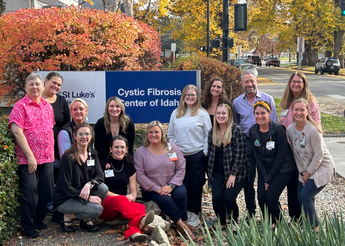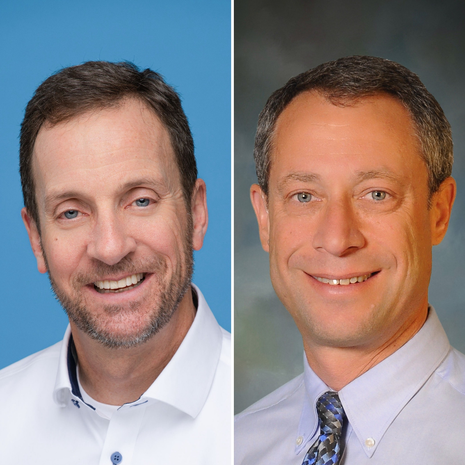Thompson joined St. Luke’s 26 years ago as Idaho’s first pediatric gastroenterologist. Just before, he had met Brown in Denver where Brown was completing his residency and Thompson a fellowship.
Previously, the Cystic Fibrosis Center in Salt Lake City would have specialists visit Boise to see patients. The Cystic Fibrosis Foundation, which both doctors highly praised, wanted to set up a new clinic in Boise.
“I said, ‘If I’m going do it, I need Perry,” Thompson said.
“They initially asked me, and I said no, since it wasn’t my area of expertise,” said Brown, a general pediatrician. “But I said, ‘I’ll only do it with Henry.’”
Cystic fibrosis is a progressive genetic disease that causes mucus in various organs to become thick and sticky. It can clog airways and lead to infections. In the pancreas, it can affect digestion and cause malnutrition. It can cause liver disease and even affect fertility in males.
Thompson had a grant during his fellowship that focused on cystic fibrosis. In 2000, life expectancy was in the early 30s, Brown said. For babies diagnosed today, it is now 65.
A typical patient visit can take approximately two hours. But the visits are comprehensive and collaborative — often preventing the need for patients to make several appointments over multiple days to connect with different physicians, providers and experts. It can all be done in one day.
Brown explained what a visit may look like:
- After being checked in by a nurse, the patient sees a pharmacist and/or pharmacy technician to make sure medications are up to date. Since patients often take many prescriptions, it is vital to ensure there are no negative interactions.
- Then, a respiratory therapist takes measurements, checks airway clearance and takes a CF pathogen culture.
- Next, a dietitian checks on any changes in appetite and ensures vitamin absorption through appropriate foods. Dieticians also make sure pediatric patients are growing on schedule.
- A social worker may then assist to check on insurance statuses and perform a mental health screening.
- Brown said at this point he may examine the patient if necessary for any concerns they may be having.
- The patient may then visit with a research coordinator, as the center typically takes part in multiple drug trials and other research efforts.
- Many will see a physical therapist for core strengthening and exercises that will help lung and heart function.
- For pediatric patients, the center has a teacher that will assist and advocate for 504 Plan students, enabling them to get their education while facing a disability.
“It would not be nearly the same if we did not have this team approach, it’s so much more efficient and coordinated,” Brown said. “You take out even one of those and the care is inferior.”
St. Luke’s has played a part in seeing the incredible advances in cystic fibrosis care and research; Brown noted that the center has been involved in trials for all five breakthrough chloride channel modulators — prescriptions that help approximately 90% of patients. The medications’ approval has coincided with the drastic increase in life expectancy.
“I tear up thinking about it … I remember we were part of the first trial, and it was like, ‘Oh this is real,’” Brown said. “I got to tell a mom of a young patient just how much things were going to change. That is an incredible feeling.”
About 15-20 years ago, Brown said on average St. Luke’s had 2.4 patients per day in its hospitals. Today, it’s about two … per year. Diagnosis has also helped, as CF screening became standard for Idaho newborns in 2007.
From being relatively new to the subject when the center opened, Brown now himself travels the country performing accreditation visits for cystic fibrosis centers. At the annual North American Cystic Fibrosis Conference, typically 5-10 St. Luke’s team members are asked to present or moderate.
“I used to tell them it was a fatal illness, but I don’t anymore,” Thompson said. “I tell parents they need to save for college now. It’s been amazing.”
Brown credits that incredible leap in life expectancy to advancements in research and drugs, but also in an approach that is central at the Cystic Fibrosis Center of Idaho. He noted studies dating back 40 years that patients who receive multidisciplinary care at a center on average live four years longer than those who do not.
“Truly team-based care,” Thompson said. “We have people that get it, enjoy it and take great care of the patients. The secret sauce is the consistency and the joy of it. There’s not just one person who is magical and controls everything, it’s a team. People believe in the mission of improving lives.”



